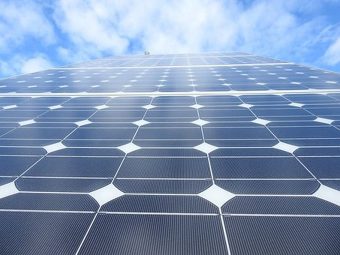
US coal and nuclear energy stakeholders are still holding out hope for their aging power plants, but the window for relief is closing fast. They face stiff competition from low-cost natural gas, and renewables are flexing their muscles, too. This is all happening before perovskite solar cells hit the market at scale. Why does this matter? New perovskite technology could drive solar costs down past conventional silicon solar cells, pushing both nuclear and fossil energy farther out of the picture.
For those of you new to the topic, perovskite refers to a class of lab-grown, crystalline materials that mimic the structure of the naturally occurring mineral perovskite.
Synthetic perovskites have caused quite a stir among photovoltaic researchers in recent years. They are relatively cheap and easy to grow in the lab, and they can be used in a thin-film format that provides the additional benefits of high volume, low-cost solar cell manufacturing.
In a perfect world, perovskites would offer a low-cost alternative to conventional silicon solar cells. Unfortunately for solar energy fans, the world is not a perfect place for perovskites because they degrade quickly when exposed to humidity.
On the bright side, there is a solution. Someone just has to find it.
The EU consortium Solliance is one of many research organizations working the problem. Last November it announced a world record of 13.5% for its thin film perovskite solar cell, and just last week it updated its perovskite PV progress. The latest iteration of the cell hit the 14.5% mark.
Last week’s announcement is also significant because Solliance demonstrated that the new cell can be interconnected with others to make a larger module without a significant loss of efficiency.
The trick is to make sure that the active material covers as much of the module as possible. Solliance shrank the non-active, interconnection areas down to a fraction. It achieved 95.3% coverage for the active areas and ended up with an efficiency of 13.5% for the module overall.
Then there’s that thing about low-cost manufacturing:
…Apart from the electrodes currently used, all layers can be processed in ambient environment and at temperatures below 120⁰C, making expensive equipment obsolete. The deposition and interconnection technologies are industrially available for both Sheet-to-Sheet and Roll-to-Roll manufacturing.
As for when you can get your hands on that low-cost thin film solar cell, that’s a good question. It doesn’t look like that will take forever, though. Panasonic is a partner in the consortium along with the “disruptive” renewable energy company Greatcell Solar Limited and the Russia-based solar business incubator Solartek.
Speaking of progress, one of the world’s biggest cheerleaders for perovskite solar cells is the National Renewable Energy Laboratory, and it has just come out with an article that outlines just how quickly things are developing in the field.
Perovskites were unstable and there were all kinds of problems—but you could clearly see in all the measurements that these were high-quality semiconductors. We saw where efficiency records were broken day after day after day. We realized this is not something we should be ignoring.
The article also makes a good case for the advantages of perovskites over silicon:
…The silicon technology requires a high-temperature manufacturing process, whereas the perovskite process is simpler: chemicals are applied to a substrate, either by deposition or roll-to-roll printing. When dry, the residue leaves crystals that serve as excellent semiconductors. This means perovskite panels are more flexible than rigid silicon panels…
At this point, NREL is confident that perovskites will break into the market. Here’s a take from NREL staff scientist David Moore:
I don’t see anything that stands in the way of commercialization of perovskite. There are a couple of challenges left. We need to make sure they’re going to last 30 years. But the strides we’re making in those areas are just as rapid as the progress we made with efficiency in the first five years. Just based on the progression of both of those things, there’s every reason to believe that we’ll continue on that path to solve those problems…
The article cites a laundry list of improvements and discoveries that NREL has made in just the past year, so if you want to see your tax dollars at work hop on over and check out “NREL Research Pushes Perovskites Closer to Market” over there at NREL.gov.
Source: cleantechnica.com


